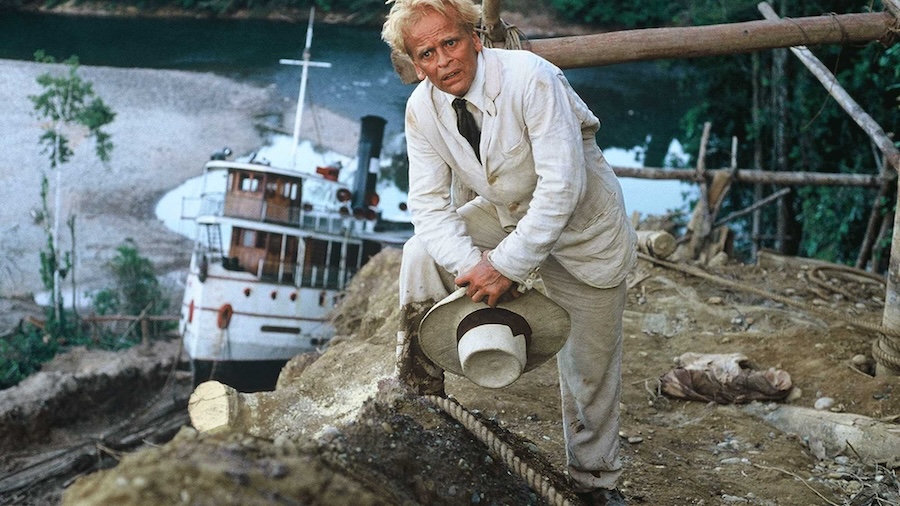

This is the kind of epic film project that makes you wonder how anyone survived. It’s the kind of film that has inspired documentaries and discussions on its troubled production. But it’s also, unlike many other similar ventures, an example of a film that avoided disaster and became a classic. After all, it did not result in Werner Herzog accepting an offer to have his lead actor murdered.
Opera on his mind
Some time at the turn of the century, Brian Sweeney Fitzgerald (Klaus Kinski), an Irish immigrant, finds himself in a small Peruvian town during a rubber boom. What’s primarily on his mind though is opera, especially the music of Enrico Caruso, and he has a dream. He wants to build an opera house in the city of Iquitos, but lacks the funds. Fitzgerald, who’s called Fitzcarraldo by the locals, is not short on ideas, however, and he comes up with a plan to finance his delightfully insane project.
He leases a parcel of land that has rubber trees but is pretty much inaccessible because of hostile natives and rapids that cut off the Ucayali River from the Amazon. With assistance from Molly (Claudia Cardinale), a brothel owner, Fitzgerald buys an old steamship and hires a crew that he hopes will take him all the way to his leased land.
Fiction turns into reality
There is some truth to the story. There was indeed a rubber baron, Carlos Fermín Fitzcarrald (Peruvian though, not Irish), who in the 1890s had a ship transported from one river to another, but not only did Werner Herzog make the ship bigger in his movie, he also added this romantic notion of Fitzcarraldo’s longing for opera. This has become one of the director’s greatest achievements, a project where fiction turns into reality. His lead character succeeds in hauling a huge steamship over a hill, and so did the filmmakers, earning Herzog comparisons with Fitzcarraldo.
It did come at a price. Extras were injured during production, there were accidents with airplanes and Herzog was accused of exploiting the indigenous people, at one point causing a rift with a tribe that hired a militia to burn down the set. Jason Robards was initially hired for the lead role, but had to abandon the project after getting sick with dysentery, leading Herzog to reconnect with Klaus Kinski, the actor who had worked with him on three previous films. This time, their legendary clashes reached a new level, to the degree that a tribal chief allegedly offered Herzog to have Kinski killed.
The Brazilian and Peruvian locations contribute to the authenticity.
Everybody in the film speaks German, which somehow makes sense only because it’s Herzog, but we’re drawn into this spectacle, partly because of the director’s skill, partly because we know what we’re watching is pretty damn near the real thing. The Brazilian and Peruvian locations contribute to the authenticity, and so does the presence of actual tribes in the area. We can smell the jungle, the sweat and the wood, and feel the tension in the air.
Coppola had his Apocalypse Now, Herzog had his Fitzcarraldo. The film is uneven at first, struggling to catch our attention as Fitzgerald’s strange obsession is plain from the start, but it’s impossible not to sympathize with a person who’s fighting so hard for something that is ultimately good and beautiful. All the powers of this world seem to be against him, but we need to see him win, even if it’s a minor victory. In the end, best fiends Herzog and Kinski deliver.
Fitzcarraldo 1982-West Germany-Peru. 157 min. Color. Written and directed by Werner Herzog. Cinematography: Thomas Mauch. Cast: Klaus Kinski (Brian Sweeney Fitzgerald), Claudia Cardinale (Molly), José Lewgoy (Don Aquilino), Miguel Ángel Fuentes, Paul Hittscher, Huerequeque Enrique Bohórquez.
Trivia: After Robards’s departure, Jack Nicholson was considered for the lead role. Mick Jagger played an assistant to Fitzcarraldo in the Robards version, but his character was cut from the film when Kinski was hired. The production of this film was chronicled in the documentary Burden of Dreams (1982).
Cannes: Best Director.
Last word: “In Fitzcarraldo, I moved a real boat over a real mountain, but it was not for the sake of realism. I’m not interested in realism. I transform a real event into pure fantasy, into something operatic. I like films where audiences can trust their own eyes, but not in a pedantic, bureaucratic way. It’s not the ‘accountant’s truth’; it’s something we’d like to see in a movie – Oh, yes! A real ship and, man, it’s moving over a mountain! – in order to create a gigantic metaphor.” (Herzog, High Profiles)
